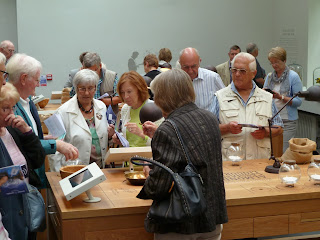TOTTON U3A
QUESTERS WALK IN THE FOREST WITH DAVE DIBDEN
THURSDAY, 8th MAY 2014
Thursday
morning saw the most persistent rain we had had for a long time and
three groups of Questers were booked to walk in the New Forest with
Dave Dibden, the coppicer who had given us such an interesting talk
last month. The first group suffered the most, with persistent rain,
but they still thoroughly enjoyed the visit. The second group had
rain to start with but dried out by the end. We were the third group
and enjoyed a dry walk, except for a few spots of rain about half way
round.
Dave
is such an enthusiastic and knowledgeable person and kept us
enthralled the whole time we wandered around his domain, which it is
hoped will become a trust managed by him in the near future. He
explained why coppicing is so important to the wildlife of the
Forest, letting the light in and promoting new growth under the
trees. The rotation ensures succeeding areas are at a different
stage of growth and the hazel can sustain this type of management for
many years. Wood harvested from these trees is not wasted and is
used for pea and bean sticks, as well as giving Dave ample material
for his fertile mind to turn into saleable items, such as delightful
pigs and bug boxes.
Charcoal
burning is one of the projects Dave is promoting to ensure an income
for the trust from the larger wood he harvests. My imagination
conjured up the charcoal burners I had seen in my youth, but the new
burner will come into the wood on a lorry and is the updated method
of producing this valuable material. Apparently many chefs in hotels
throughout the Forest use charcoal grills and will appreciate such a
local source.
Dave
led us through the bluebell woods which now bloom under his care.
These were intermingled with white stitchwort and produced a
beautiful carpet among the trees. The vegetation along the verges
has also been cut back and native flowers now flourish here to
encourage the return of many species of butterfly. These were sadly
lacking after the rain, but the violets, bugle, bluebells, stitchwort
and many other plants were a beautiful sight.
Dave
led us on to his latest clearance project. He undertakes this during
the winter months of November to February and he stacks the brushwood
around the perimeter to deter deer which always manage to get in
somehow, especially the Muntjac, which are small and difficult to
spot. He then harvests the timber, stacking it and leaving the tree
stumps to generate new growth, which we could already see.
Our
walk lasted about 1½ hours and we learned so much on our ramble -
how to identify some of the trees and flowers, why conservation is so
important for our wildlife and how satisfying it is for someone to be
doing what he loves best, working in the Forest.
Sue











































